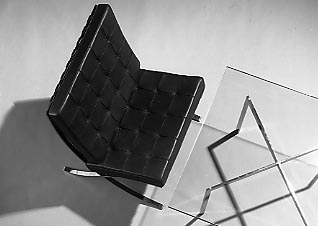
Barcelona Chair
Mies Van Der Rohe, Ludwig
1929
Artwork Information
-
Title:
Barcelona Chair
-
Artist:
Mies Van Der Rohe, Ludwig
-
Artist Bio:
American, 1886–1969
-
Date:
1929
-
Medium:
Nickel-plated steel and leather
-
Dimensions:
30 1/4 x 30 x 29 3/4 inches
-
Credit Line:
Wichita Art Museum, Gift of the American Institute of Architects, Wichita
-
Object Number:
1976.4.2
-
Display:
Not Currently on Display
About the Artwork
Among the furniture in the permanent collection is the Barcelona Chair, one of the design icons of the twentieth century. The chair achieved its canonical status due to its disciplined yet extremely elegant line, its classical beauty, and the sensuousness proportions, its width being greater than its depth. And it achieved perfect grace through the intersection of its frame and legs. The machine-made appearance of the chair is a paradox, since impeccable hand craftsmanship is required to produce it.
Why would a collection that focuses on American art include a chair designed by a German for a model house at an exposition in Barcelona, Spain? The answer lies principally in the influence of the chair and its designer on the image and identity of so many Americans. Though Mies was German, he emigrated to the U.S. in 1938 as one of the many victims of Nazi intolerance.
He was soon appointed director of the architecture school at the Illinois Institute of Technology, Chicago, where he remained until 1958. His concepts and ideals of architecture as taught at I.I.T., along with the buildings he realized as head of his own architectural office, made him the most influential architect of the second half of the twentieth century. His belief in truth and order in life and art, his simplification of form based on mathematical principles, and his insistence on quality allowed his clients to sense that they were inhabiting the ultimate machine for aesthetic living. . . and working. . . a domestication of the precision and systematization of a well-run factory. The way to achieve that sense in an interior not designed by Mies was to incorporate into it furniture designed by him.
From around 1950 on, the presence of Mies furniture in a room conveyed the image that the inhabitant was intellectual, refined, and rational. No piece of Mies furniture conveyed that image more directly than the Barcelona Chair.